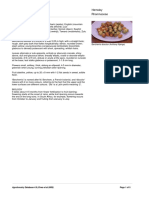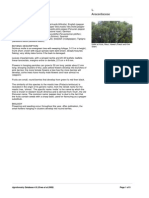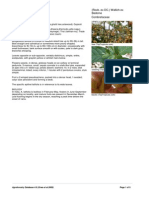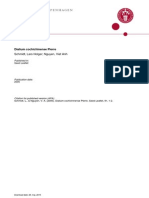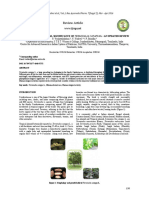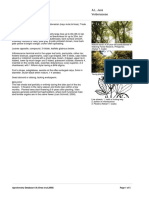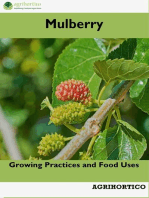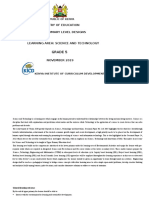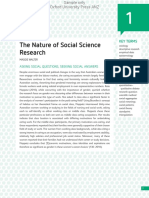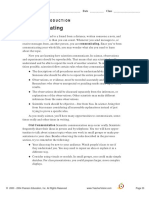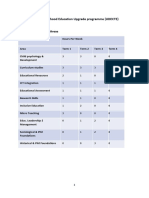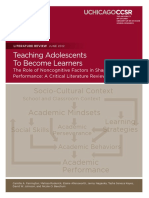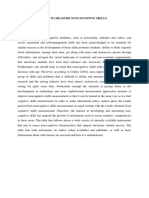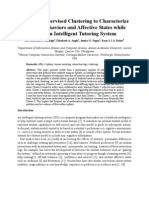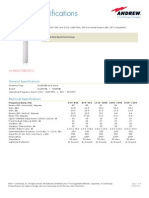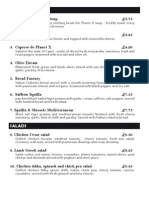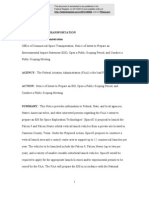Professional Documents
Culture Documents
Trichilia Emetica: Meliaceae Vahl
Uploaded by
Kaberia MberiaOriginal Title
Copyright
Available Formats
Share this document
Did you find this document useful?
Is this content inappropriate?
Report this DocumentCopyright:
Available Formats
Trichilia Emetica: Meliaceae Vahl
Uploaded by
Kaberia MberiaCopyright:
Available Formats
Trichilia emetica Vahl
Meliaceae
mafura nut
LOCAL NAMES
Afrikaans (basteressenhout,rooi-essenhout); Amharic (mahogani); Arabic
(umshara,um hagi,safsafa); Bemba (mushikishi); Bislama (kota); English
(Natal mahogany,woodland mahogany,christmas bells,red ash,thunder
tree,Cape mahogany); Hausa (jan saiwa); Lozi (musikili); Nyanja (msikizi);
Portuguese (m’chekeri,mafurreia); Somali (gor-mas); Swahili
(mafura,mkungwina,mnwamaji,mtimai,mtimaji,musikili,muwamaji);
Tigrigna (gumeh); Tongan (musikili); Trade name (mafura nut); Tswana
(mosikiri); Yoruba (ashapa); Zulu (iGwolo,uMathunzini,umKhuhlu)
Trichilia emetica slash (Joris de Wolf,
BOTANIC DESCRIPTION Patrick Van Damme, Diego Van
Trichilia emetica is an evergreen tree, usually up to 21 m tall but Meersschaut)
occasionally reaching 30 m, trunk swollen at the base, sometimes
becoming fluted with age. Bark grey-brown or red-brown with fine, shallow
striations and smallish scales. Branches erect or partly spreading,
producing a pyramid-shaped crown when young, oval to rounded and
dense when mature with a diameter sometimes exceeding 15 m. The tree
has a non-aggressive root system.
Leaves up to 50 cm long, unevenly compound with 3-5 pairs of leaflets
plus a terminal one, dark green and glossy above, covered with short
brownish hairs below, margins entire, veins prominent on lower surface.
Trichilia emetica foliage (Joris de Wolf,
Patrick Van Damme, Diego Van
Flowers creamy to pale yellow-green, produced on short, congested Meersschaut)
axillary panicles, fragrant, with 5 thick petals, about 2 cm, surrounding a
hairy centre of stamens.
Fruit rounded, furry, red-brown capsules to 3 cm across, split into 3 or 4
parts to reveal 3-6 shiny black seeds 14-18 mm in length, each with a
fleshy scarlet or orange-red aril almost covering the seed. A clear neck to
1 cm long connects the capsule to the fruit stalk.
The name ‘Trichilia’ is Greek for ‘in 3 parts’, referring to the 3-lobed fruit,
and ‘emetica’ means with emetic properties.
(Joris de Wolf, Patrick Van Damme, Diego
BIOLOGY Van Meersschaut)
Seeds are too heavy to be spread by wind, and they fall to the ground; no
animal or bird is known to disperse them. In South Africa, flowering occurs
from August to November and fruiting from December to April.
Agroforestry Database 4.0 (Orwa et al.2009) Page 1 of 5
Trichilia emetica Vahl
Meliaceae
mafura nut
ECOLOGY
T. emetica is locally frequent in riparian forest and in some types of munga woodland, and can be found occasionally in
swamp forest, montane forest, savannah or alluvial lowland rainforest and escarpment miombo. It is regarded as an
indicator of areas with palatable grass species. It grows naturally through sub-Saharan Africa from Senegal to the Red
Sea, throughout East and Central Africa to Congo and South Africa.
BIOPHYSICAL LIMITS
Altitude: 0-1300 m, Mean annual temperature: 19-31 deg. C, Mean annual rainfall: 600-2300 mm
Soil type: Prefers well-drained, rich alluvial or sandy soil and a high water table.
DOCUMENTED SPECIES DISTRIBUTION
Native: Botswana, Burkina Faso, Chad, Congo, Eritrea, Ethiopia, Guinea, Guinea-Bissau, Kenya, Malawi,
Mali, Mozambique, Namibia, Nigeria, Senegal, Somalia, South Africa, Sudan, Swaziland, Tanzania,
Uganda, Yemen, Republic of, Zambia, Zimbabwe
Exotic:
Native range
Exotic range
The map above shows countries where the species has been planted. It does neither
suggest that the species can be planted in every ecological zone within that country,
nor that the species can not be planted in other countries than those depicted. Since
some tree species are invasive, you need to follow biosafety procedures that apply to
your planting site.
Agroforestry Database 4.0 (Orwa et al.2009) Page 2 of 5
The map above shows countries where the species has been planted. It does neither
suggest that the species can be planted in every ecological zone within that country,
nor that the species can not be planted in other countries than those depicted. Since
Trichilia emetica Vahl
some tree species are invasive, you need to follow biosafety procedures that apply to
your planting site. Meliaceae
mafura nut
PRODUCTS
Food: A sweet, milky, potable liquid is extracted from the arils. The skinned seeds are also edible and are eaten raw or
soaked in water and ground, the resultant liquid mixed with spinach dishes.
Fodder: Domestic animals feed on its leaves.
Apiculture: The tree is occasionally used for bee forage. Sunbirds visit the nectar-rich flowers.
Fuel: A fuelwood species, T. emetica is commonly used for firewood.
Timber: Wood is soft yet firm and works well. There is no real distinction between sapwood and heartwood, usually
pinkish in colour and light (560-597 kg/m³), vulnerable to borers and should be treated accordingly. The wood produces
beautiful furniture, which darkens with the application of furniture oil. It is also good quality for shelving, and is popular
for carvings, musical instruments and various household articles. Trees with long, straight trunks are cut and used for
dugout canoes. Owing to its flexibility and good turning properties, it is also good for tool handles and spears.
Lipids: Trichilia oil produces a good finish on wood surfaces and could compete successfully with other commercial
wood oils. The seed contains high oil concentrations as most oil-rich dicotyledonous seeds. Fresh seed yield
approximately 64.7 ml oil/kg, using a simple ram press (yield from the whole seed is 58-68%, the seed coat contains 14-
51%, and the kernel 68% oil).
Wax: Seed oil (mafurra or mafurreira tallow) is used for candle making.
Poison: The seed coat is extremely poisonous.
Medicine: The leaves can be used as an antidote for the irritation caused by the buffalo bean, whilst the bark is used in
the treatment of skin complaints. Pieces of bark or powdered bark are soaked in warm water and used as an emetic or
enema. Roots and the oil from the seed also have medicinal qualities; a bitter-tasting medicinal oil, obtained by boiling
the ground seed in water, is taken orally to relieve rheumatism.
Other products: The kernels and husks of the nut produce a very good soap-making oil, which is sometimes used as a
cosmetic and can also be used for preserving foodstuffs. For example, in eastern and southern Africa, oil is extracted
on a small industrial scale and used in soap manufacture. The leaves have some soapy properties as well. Seed used
to be exported from Mozambique under the name ‘mafura’ or ‘mafurreira nut’.
SERVICES
Erosion control: Planting T. emetica greatly assists in soil conservation.
Shade or shelter: A worthwhile tree to provide shade and protection for livestock, and an excellent tree for the garden
with its fast growth and wide crown. Widely planted as a windbreak in urban and rural areas.
Soil improver: The pressed seedcake left after oil has been extracted, with an approximate protein content of 16%, is
suitable as a fertilizer.
Ornamental: T. emetica has been widely planted as a street or garden tree. Ideal for car-parking areas as it never grows
very high and has an evergreen, spreading crown.
Agroforestry Database 4.0 (Orwa et al.2009) Page 3 of 5
Trichilia emetica Vahl
Meliaceae
mafura nut
TREE MANAGEMENT
T. emetica is a fast-growing species; up to 1 m/year in colder areas and 2 m in warmer areas. It should be planted in
groups near water in shade or full sun. Not resistant to frost and is therefore more suited to warmer areas, but can
survive long periods of drought.
GERMPLASM MANAGEMENT
Seed storage behaviour is recalcitrant; seeds are sensitive to desiccation and cannot be stored because they lose
viability within a short time. There are approximately 200-300 seeds/kg.
PESTS AND DISEASES
The pink-grey-brown timber is very susceptible to insect attack. The larvae of the whitebarred charaxes butterfly
(Charaxes brutus natalensis) feed on the leaves of the tree.
Agroforestry Database 4.0 (Orwa et al.2009) Page 4 of 5
Trichilia emetica Vahl
Meliaceae
mafura nut
FURTHER READNG
Albrecht J. ed. 1993. Tree seed hand book of Kenya. GTZ Forestry Seed Center Muguga, Nairobi, Kenya.
Beentje HJ. 1994. Kenya trees, shrubs and lianas. National Museums of Kenya.
Bein E. 1996. Useful trees and shrubs in Eritrea. Regional Soil Conservation Unit (RSCU), Nairobi, Kenya.
Bekele-Tesemma A, Birnie A, Tengnas B. 1993. Useful trees and shrubs for Ethiopia. Regional Soil Conservation Unit
(RSCU), Swedish International Development Authority (SIDA).
Coates-Palgrave K. 1988. Trees of southern Africa. C.S. Struik Publishers Cape Town.
Eggeling. 1940. Indigenous trees of Uganda. Govt. of Uganda.
FAO. 1983. Food and fruit bearing forest species. 1: Examples from Eastern Africa. FAO Forestry Paper. 44/1. Rome.
FAO. 1986. Some medicinal plants of Africa and Latin America. FAO Forestry Paper. 67. Rome.
Friis I. 1992. Forests and forest trees of northeast tropical Africa. Her Majesty’s Stationery Office, London.
Grundy IM, Campbell BM. 1992. Potential production and utilization of oil from Trichilia species (Meliacaea). Economic
Botany. 47(2):148-153.
Hines DA, Eckman K. 1993. Indigenous multipurpose trees for Tanzania: uses and economic benefits to the people.
Cultural survival Canada and Development Services Foundation of Tanzania.
Hong TD, Linington S, Ellis RH. 1996. Seed storage behaviour: a compendium. Handbooks for Genebanks: No. 4.
IPGRI.
ICRAF. 1992. A selection of useful trees and shrubs for Kenya: Notes on their identification, propagation and
management for use by farming and pastoral communities. ICRAF.
Matakala P, Macucule A, Mausse A. 2004. Local knowledge, uses and agroforestry potentials of Mafurra, Trichilia
emetica, Vahl: preliminary report of the study carried out in Inharrime, Zavala e Chidenguele. Nairobi, Kenya: ICRAF.
40p.
Matakala P, Mausse A, Macucule A. 2005. Local indigenous knowledge, uses and agroforestry potential of mafurra,
Trichilia emetica, val. Nairobi, Kenya: World Agroforestry Centre ICRAF. 50p.
Mbuya LP et al. 1994. Useful trees and shrubs for Tanzania: Identification, Propagation and Management for
Agricultural and Pastoral Communities. Regional Soil Conservation Unit (RSCU), Swedish International Development
Authority (SIDA).
Msanga HP, Maghembe JA. 1993. Germination of woodland mahogany (Trichilia emetica) following manual scarification
and potassium nitrate treatments. Journal of Tropical Forest Science. 5(4): 518-527.
Noad T, Birnie A. 1989. Trees of Kenya. General Printers, Nairobi.
Palmer E, Pitman N. 1972. Trees of Southern Africa Vol. 2. A.A. BalKema Cape Town.
Storrs AEG. 1995. Know your trees: some common trees found in Zambia. Regional Soil Conservation Unit (RSCU).
Vaughan JG. 1970. The structure and utilization of oil seeds. Chapman and Hall Ltd.
Venter F, Venter J-A. 1996. Making the most of Indigenous trees. Briza Publications.
SUGGESTED CITATION
Orwa C, Mutua A , Kindt R , Jamnadass R, Simons A. 2009. Agroforestree Database:a tree reference and selection guide
version 4.0 (http://www.worldagroforestry.org/af/treedb/)
Agroforestry Database 4.0 (Orwa et al.2009) Page 5 of 5
You might also like
- Research ProposalDocument10 pagesResearch ProposalRonNo ratings yet
- Childrens VoiceDocument26 pagesChildrens VoiceMira Alaa100% (2)
- Berchemia DiscolorDocument5 pagesBerchemia DiscolorvitazzoNo ratings yet
- Dacryodes Edulis: Burseraceae (G. Don.) H. J. LamDocument6 pagesDacryodes Edulis: Burseraceae (G. Don.) H. J. LamvitazzoNo ratings yet
- Trichilia Emetica TZADocument2 pagesTrichilia Emetica TZAKaberia MberiaNo ratings yet
- Ekebergia Capensis: Meliaceae SparrmanDocument5 pagesEkebergia Capensis: Meliaceae SparrmanvitazzoNo ratings yet
- Juniperus Procera: Cupressaceae Hochst. Ex EndlDocument5 pagesJuniperus Procera: Cupressaceae Hochst. Ex EndlgravitzNo ratings yet
- Maesopsis EminiiDocument5 pagesMaesopsis EminiiRizki Ersa HeryanaNo ratings yet
- Flacourtia IndicaDocument5 pagesFlacourtia IndicaGiffaria HafizhaNo ratings yet
- Tamarind tree usesDocument6 pagesTamarind tree usesZhafronsya Alfarij NurzainNo ratings yet
- Taxus BaccataDocument5 pagesTaxus BaccataIrikaNo ratings yet
- Schinus MolleDocument5 pagesSchinus MolleFlower Rouss AQNo ratings yet
- Dalbergia MelanoxylonDocument5 pagesDalbergia MelanoxylonNeemahNo ratings yet
- Spondias Mombin: Anacardiaceae LDocument5 pagesSpondias Mombin: Anacardiaceae LMaria José PradoNo ratings yet
- Vernonia Factsheet PDFDocument2 pagesVernonia Factsheet PDFSo NicNo ratings yet
- Gmelina Arborea: Verbenaceae RoxbDocument5 pagesGmelina Arborea: Verbenaceae RoxbHensim Mae CajesNo ratings yet
- Mammea americana: A Tropical Fruit Tree Native to the CaribbeanDocument5 pagesMammea americana: A Tropical Fruit Tree Native to the CaribbeanvitazzoNo ratings yet
- Myrica salicifolia uses and ecologyDocument2 pagesMyrica salicifolia uses and ecologyAmbachew HagosNo ratings yet
- Anogeissus LatifoliaDocument5 pagesAnogeissus LatifoliaDr.TamilvelanNo ratings yet
- Genipa americana: The marmalade box treeDocument5 pagesGenipa americana: The marmalade box treevitazzoNo ratings yet
- Jujube TreeDocument6 pagesJujube TreeRiky SetiawanNo ratings yet
- Elaeis Guineensis: Arecaceae JacqDocument5 pagesElaeis Guineensis: Arecaceae JacqAnonymous m35iKgHNo ratings yet
- Acacia Seyal: Fabaceae - Mimosoideae DelDocument5 pagesAcacia Seyal: Fabaceae - Mimosoideae DelJUAN PABLO MORENONo ratings yet
- Flemingia MacrophyllaDocument2 pagesFlemingia MacrophyllaTravisNo ratings yet
- Fraxinus excelsior: The Common European AshDocument5 pagesFraxinus excelsior: The Common European AshKarelNo ratings yet
- Guinea GrassDocument4 pagesGuinea GrassJan Rei Lañohan100% (1)
- Ecology Project Group 3Document58 pagesEcology Project Group 3MntesnotNo ratings yet
- Vangueria infausta fruit and usesDocument5 pagesVangueria infausta fruit and usesNanoManNo ratings yet
- Family Myrtaceae: TBB 2043 Biodiversity and Evolution of Monera, Fungi and Plantae Kumpulan A - Group 1Document62 pagesFamily Myrtaceae: TBB 2043 Biodiversity and Evolution of Monera, Fungi and Plantae Kumpulan A - Group 1Lihun WongNo ratings yet
- Melia volkensii Guide: Uses, Description and CareDocument5 pagesMelia volkensii Guide: Uses, Description and CareKaberia MberiaNo ratings yet
- Uapaca Kirkiana: Euphorbiaceae Muell. ArgDocument6 pagesUapaca Kirkiana: Euphorbiaceae Muell. ArgvitazzoNo ratings yet
- Dialium IndumDocument3 pagesDialium IndumNur Farhanah ZulkifliNo ratings yet
- Khaya AnthotecaDocument16 pagesKhaya AnthotecaPhilip Worlanyo DugbleyNo ratings yet
- Plants For Major Highways and Major Roads: Landscape ArchitectureDocument41 pagesPlants For Major Highways and Major Roads: Landscape ArchitectureCapao PadillaNo ratings yet
- Erythrina Edulis: Fabaceae - Papilionoideae Triana Ex M. MicheliDocument5 pagesErythrina Edulis: Fabaceae - Papilionoideae Triana Ex M. MichelivitazzoNo ratings yet
- 1 1 24.1Document9 pages1 1 24.1abatabrahamNo ratings yet
- Phytopharmalogical Significance of Terminalia Catappa An Updated ReviewDocument8 pagesPhytopharmalogical Significance of Terminalia Catappa An Updated ReviewYonita Yuliani100% (1)
- Tournefortia ArgenteaDocument12 pagesTournefortia ArgenteaDoug OhnemusNo ratings yet
- Mangifera Caesia: Anacardiaceae JackDocument5 pagesMangifera Caesia: Anacardiaceae JackvitazzoNo ratings yet
- Cryptomeria JaponicaDocument5 pagesCryptomeria JaponicaFitzgerald BillyNo ratings yet
- Name of Plants in The Damara TraditionsDocument5 pagesName of Plants in The Damara TraditionsHafeni tulongeni HamukotoNo ratings yet
- Cengkeh (Syzygium Aromaticum)Document5 pagesCengkeh (Syzygium Aromaticum)Odi Gita Nasution PradanaNo ratings yet
- ActaHortic. - MoringaDocument12 pagesActaHortic. - MoringaMarinaNo ratings yet
- Romerillo Podocarpus Glomeratus The Bat Falcon (Murcielago Halcon) Falco RufigularisDocument2 pagesRomerillo Podocarpus Glomeratus The Bat Falcon (Murcielago Halcon) Falco RufigularisMelina LizyNo ratings yet
- Moringa OleiferaDocument13 pagesMoringa OleiferaEmcee WaterNo ratings yet
- Feronia Limonia: Rutaceae (L.) SwingleDocument5 pagesFeronia Limonia: Rutaceae (L.) SwinglevitazzoNo ratings yet
- Kigelia Africana IntDocument2 pagesKigelia Africana IntMia Audina MiyanoshitaNo ratings yet
- TamarindDocument31 pagesTamarind20UHR011 Mohan KumarNo ratings yet
- Terminalia ca-WPS OfficeDocument4 pagesTerminalia ca-WPS OfficePraise ChiamakaNo ratings yet
- Eugenia stipitata fruit and usesDocument5 pagesEugenia stipitata fruit and usesvitazzoNo ratings yet
- Vitex Parviflora: Verbenaceae A.L. JussDocument5 pagesVitex Parviflora: Verbenaceae A.L. JussQuimark Vestidas MartinezNo ratings yet
- Dialium Guineense: Fabaceae - Caesalpinioideae WilldDocument5 pagesDialium Guineense: Fabaceae - Caesalpinioideae WilldvitazzoNo ratings yet
- Acacia Crassicarpa A. Cunn. Ex Benth. (Australian Wattle)Document5 pagesAcacia Crassicarpa A. Cunn. Ex Benth. (Australian Wattle)edisonNo ratings yet
- Phyllanthus Acidus PDFDocument5 pagesPhyllanthus Acidus PDFKishore PriyadharsanNo ratings yet
- Allamanda cathartica guideDocument2 pagesAllamanda cathartica guideShivansh Singh GautamNo ratings yet
- Chamaecytisus palmensis: Evergreen Shrub Provides Fodder and MoreDocument5 pagesChamaecytisus palmensis: Evergreen Shrub Provides Fodder and Morela77silvaNo ratings yet
- Vitex PubescensDocument5 pagesVitex PubescensLinda Rusliana SariNo ratings yet
- 18BBO53C-U2Document21 pages18BBO53C-U2Dr. Shriram KunjamNo ratings yet
- Mwangomo-Assigniment 01Document86 pagesMwangomo-Assigniment 01Denis MwangomoNo ratings yet
- Trees Inside Benguet State University PDFDocument39 pagesTrees Inside Benguet State University PDFDerrick Yson (Mangga Han)No ratings yet
- Grade 6 Science and TechnologyDocument43 pagesGrade 6 Science and TechnologyKaberia MberiaNo ratings yet
- Data-Driven Instruction in The Classroom: January 2015Document5 pagesData-Driven Instruction in The Classroom: January 2015Kaberia MberiaNo ratings yet
- Data-Driven Instruction in The Classroom: January 2015Document5 pagesData-Driven Instruction in The Classroom: January 2015Kaberia MberiaNo ratings yet
- Science and Technology Grade 5 14th Dec. 2019Document34 pagesScience and Technology Grade 5 14th Dec. 2019Kaberia MberiaNo ratings yet
- Full Article Can Be Accessed At:: S0736585318304234-Main PDFDocument1 pageFull Article Can Be Accessed At:: S0736585318304234-Main PDFKaberia MberiaNo ratings yet
- Resources and Activities For KindergartenDocument32 pagesResources and Activities For KindergartenKaberia MberiaNo ratings yet
- Ricinus Communis: Indigenous To AfricaDocument2 pagesRicinus Communis: Indigenous To AfricaKaberia MberiaNo ratings yet
- Full Article Can Be Accessed At:: S0736585318304234-Main PDFDocument1 pageFull Article Can Be Accessed At:: S0736585318304234-Main PDFKaberia MberiaNo ratings yet
- Annex 1Document7 pagesAnnex 1Kaberia MberiaNo ratings yet
- Walter Socialresearch3e SampleDocument22 pagesWalter Socialresearch3e SampleAwinash kumarNo ratings yet
- Communicating: Skills IntroductionDocument4 pagesCommunicating: Skills IntroductionKaberia MberiaNo ratings yet
- Diploma in Early Childhood Education Upgrade ProgrammeDocument2 pagesDiploma in Early Childhood Education Upgrade ProgrammeKaberia MberiaNo ratings yet
- Melia volkensii Guide: Uses, Description and CareDocument5 pagesMelia volkensii Guide: Uses, Description and CareKaberia MberiaNo ratings yet
- Brochure Atti Convegno Roma24112014-1Document19 pagesBrochure Atti Convegno Roma24112014-1Markus MarkNo ratings yet
- Multi Channel Av Receiverstr-Dh750/Str-DH550: ProtectorDocument8 pagesMulti Channel Av Receiverstr-Dh750/Str-DH550: ProtectorKaberia MberiaNo ratings yet
- CBC Lesson PlanDocument2 pagesCBC Lesson PlanKaberia Mberia100% (1)
- Teaching Adolescents to Become Learners: The Role of Noncognitive FactorsDocument108 pagesTeaching Adolescents to Become Learners: The Role of Noncognitive FactorsKaberia MberiaNo ratings yet
- Diploma in Primary Teacher Education Upgrade ProgrammeDocument2 pagesDiploma in Primary Teacher Education Upgrade ProgrammeKaberia MberiaNo ratings yet
- Generic Model For GNGDocument10 pagesGeneric Model For GNGKaberia MberiaNo ratings yet
- European Journal of Education Studies: Minae I. Mwangi, David KhateteDocument15 pagesEuropean Journal of Education Studies: Minae I. Mwangi, David KhateteKaberia MberiaNo ratings yet
- How To Measure Noncognitive SkillsDocument9 pagesHow To Measure Noncognitive SkillsUshaNo ratings yet
- Digitalcommons@University of Nebraska - Lincoln Digitalcommons@University of Nebraska - LincolnDocument18 pagesDigitalcommons@University of Nebraska - Lincoln Digitalcommons@University of Nebraska - LincolnKaberia MberiaNo ratings yet
- Review On Determining Number of Cluster in K-Means ClusteringDocument6 pagesReview On Determining Number of Cluster in K-Means ClusteringKaberia MberiaNo ratings yet
- Psychological factors predict math performanceDocument8 pagesPsychological factors predict math performanceKaberia MberiaNo ratings yet
- 000what Do We Know About Developing Students' Non-Cognitive Skills - John HopkinsDocument9 pages000what Do We Know About Developing Students' Non-Cognitive Skills - John HopkinsKaberia MberiaNo ratings yet
- Use of Unsupervised Clustering To Characterize Learner Behaviors and Affective States While Using An Intelligent Tutoring SystemDocument8 pagesUse of Unsupervised Clustering To Characterize Learner Behaviors and Affective States While Using An Intelligent Tutoring SystemJessica O SugayNo ratings yet
- Using Cluster Analysis For Data Mining in Educational TechnologyDocument17 pagesUsing Cluster Analysis For Data Mining in Educational TechnologyKaberia MberiaNo ratings yet
- Semantic Resource Management For The WebDocument10 pagesSemantic Resource Management For The WebKaberia MberiaNo ratings yet
- Technical Data Book: RAC For SEDA (INV, R410A, 60Hz, C/O)Document43 pagesTechnical Data Book: RAC For SEDA (INV, R410A, 60Hz, C/O)joserosineiassisdasilvaNo ratings yet
- DLL G5 Q1 Week 3 All SubjectsDocument64 pagesDLL G5 Q1 Week 3 All SubjectsMary Eilleen CabralNo ratings yet
- Dupont Heir Sexually Abuses DaughterDocument3 pagesDupont Heir Sexually Abuses DaughterJuandelaCruzNo ratings yet
- Wazaif Totaky Home Remedies Receiver Software Powervu Key-1Document18 pagesWazaif Totaky Home Remedies Receiver Software Powervu Key-1Habib MohammedNo ratings yet
- CPR Team DynamicsDocument31 pagesCPR Team Dynamicsapi-205902640No ratings yet
- Jear C PB 2018 PDFDocument174 pagesJear C PB 2018 PDFArasu RajendranNo ratings yet
- Site Comp End 02Document66 pagesSite Comp End 02Parameswararao BillaNo ratings yet
- Ecosystem Components and InteractionsDocument31 pagesEcosystem Components and InteractionsBirraa TajuNo ratings yet
- Oil Record Book InstructionsDocument6 pagesOil Record Book InstructionsNamal Fernando100% (1)
- DBXLH 8585B VTMDocument4 pagesDBXLH 8585B VTMmau_mmx5738No ratings yet
- NeseritideDocument28 pagesNeseritideNavojit Chowdhury100% (1)
- Hyperfunctional Voice DisordersDocument11 pagesHyperfunctional Voice DisordersJam PNo ratings yet
- Nikon Nivo C Series Instruction ManualDocument65 pagesNikon Nivo C Series Instruction ManualBambang Deriyanto100% (1)
- Ventilation System Comparison - Constant Air Volume (CAV) and Variable Air Volume (VAV)Document15 pagesVentilation System Comparison - Constant Air Volume (CAV) and Variable Air Volume (VAV)ankurNo ratings yet
- Name: Sport: Movement PrepDocument24 pagesName: Sport: Movement PrepS HNo ratings yet
- Analysis of Alloy Constituents (Cu and ZnDocument5 pagesAnalysis of Alloy Constituents (Cu and Znaryan kushwaha100% (2)
- Planet X Restaurant Menu v2Document5 pagesPlanet X Restaurant Menu v2Chinthaka WilliamsNo ratings yet
- SpaceX ProposalDocument6 pagesSpaceX ProposalTexas WatchdogNo ratings yet
- Flame Amplifier HoneywellDocument8 pagesFlame Amplifier Honeywellgavo vargoNo ratings yet
- Examination of Power Electronics (Pel) : AnswerDocument10 pagesExamination of Power Electronics (Pel) : Answerves vegasNo ratings yet
- ZinkPower Batam - Company BrochureDocument6 pagesZinkPower Batam - Company BrochureansarALLAAHNo ratings yet
- Storage Tank: Data Sheet ForDocument2 pagesStorage Tank: Data Sheet ForAmanNo ratings yet
- Riel Comun Fstguide2Document2 pagesRiel Comun Fstguide2Rosita TejedaNo ratings yet
- Urban Heat Island effect document answersDocument4 pagesUrban Heat Island effect document answersAlainDelonTahilLanaNo ratings yet
- ELCO Brochure FGR (ENG) 1.2Document16 pagesELCO Brochure FGR (ENG) 1.2Mohd Bismillah AnsariNo ratings yet
- 4 ReactorsDocument58 pages4 ReactorsKiran ShresthaNo ratings yet
- Argumentative EssayDocument5 pagesArgumentative Essayapi-538443988No ratings yet
- How To Check A Capacitor With Digital Multimeter and Analog AVO Meter. by Four (5) Methods With Pictorial ViewDocument7 pagesHow To Check A Capacitor With Digital Multimeter and Analog AVO Meter. by Four (5) Methods With Pictorial ViewDivagar PNo ratings yet


